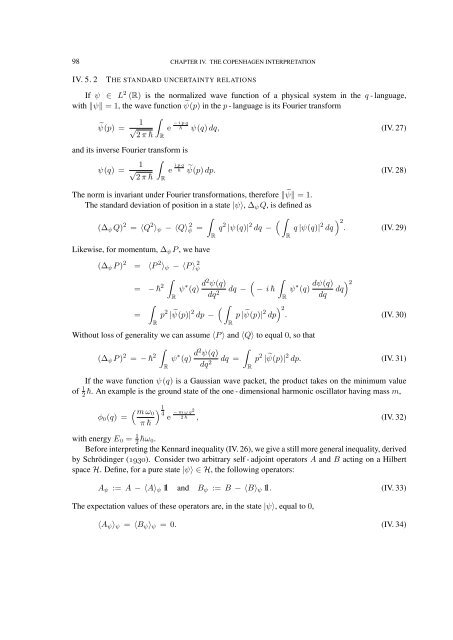FOUNDATIONS OF QUANTUM MECHANICS
FOUNDATIONS OF QUANTUM MECHANICS
FOUNDATIONS OF QUANTUM MECHANICS
You also want an ePaper? Increase the reach of your titles
YUMPU automatically turns print PDFs into web optimized ePapers that Google loves.
98 CHAPTER IV. THE COPENHAGEN INTERPRETATION<br />
IV. 5. 2<br />
THE STANDARD UNCERTAINTY RELATIONS<br />
If ψ ∈ L 2 (R) is the normalized wave function of a physical system in the q - language,<br />
with ∥ψ∥ = 1, the wave function ˜ψ(p) in the p - language is its Fourier transform<br />
˜ψ(p) =<br />
∫<br />
1<br />
√<br />
2 π <br />
R<br />
e − i p q<br />
ψ(q) dq, (IV. 27)<br />
and its inverse Fourier transform is<br />
∫<br />
1<br />
ψ(q) = √ e i p q<br />
˜ψ(p) dp. (IV. 28)<br />
2 π <br />
R<br />
The norm is invariant under Fourier transformations, therefore ∥ ˜ψ∥ = 1.<br />
The standard deviation of position in a state |ψ⟩, ∆ ψ Q, is defined as<br />
∫<br />
( ∫ ) 2.<br />
(∆ ψ Q) 2 = ⟨Q 2 ⟩ ψ − ⟨Q⟩ ψ 2 = q 2 |ψ(q)| 2 dq − q |ψ(q)| 2 dq (IV. 29)<br />
R<br />
R<br />
Likewise, for momentum, ∆ ψ P , we have<br />
(∆ ψ P ) 2 = ⟨P 2 ⟩ ψ − ⟨P ⟩ ψ<br />
2<br />
∫<br />
= − 2 ψ ∗ (q) d2 ψ(q)<br />
( ∫<br />
R dq 2 dq − − i ψ ∗ (q) dψ(q) ) 2<br />
dq<br />
R dq<br />
∫<br />
= p 2 | ˜ψ(p)|<br />
( ∫ 2. 2 dp − p | ˜ψ(p)| dp) 2 (IV. 30)<br />
R<br />
R<br />
Without loss of generality we can assume ⟨P ⟩ and ⟨Q⟩ to equal 0, so that<br />
of 1 2<br />
(∆ ψ P ) 2 = − 2 ∫<br />
R<br />
ψ ∗ (q) d2 ψ(q)<br />
dq 2 dq =<br />
∫<br />
R<br />
p 2 | ˜ψ(p)| 2 dp. (IV. 31)<br />
If the wave function ψ (q) is a Gaussian wave packet, the product takes on the minimum value<br />
. An example is the ground state of the one - dimensional harmonic oscillator having mass m,<br />
ϕ 0 (q) =<br />
( m ω0<br />
π <br />
) 1<br />
4 e − m ω q2<br />
2 , (IV. 32)<br />
with energy E 0 = 1 2 ω 0.<br />
Before interpreting the Kennard inequality (IV. 26), we give a still more general inequality, derived<br />
by Schrödinger (1930). Consider two arbitrary self - adjoint operators A and B acting on a Hilbert<br />
space H. Define, for a pure state |ψ⟩ ∈ H, the following operators:<br />
A ψ := A − ⟨A⟩ ψ 11 and B ψ := B − ⟨B⟩ ψ 11. (IV. 33)<br />
The expectation values of these operators are, in the state |ψ⟩, equal to 0,<br />
⟨A ψ ⟩ ψ = ⟨B ψ ⟩ ψ = 0. (IV. 34)
















